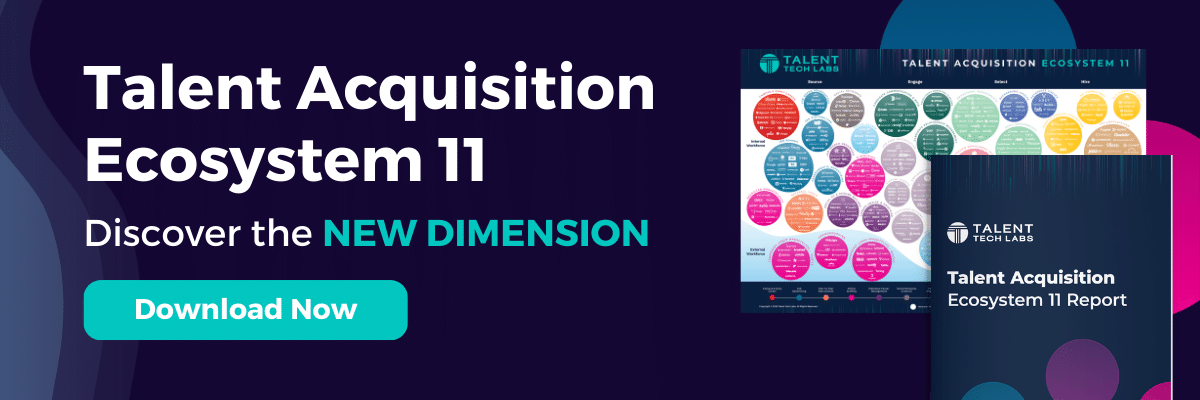In the first 4 parts of our 10th Edition Ecosystem we took a deeper look at the changes and evolutions to the 4 stages, Source, Engage, Select, and Hire. Over the course of the last 10 Ecosystems, the overall structure has remained unchanged, but the changes to the verticals, sub-verticals, and vendor levels are worth discussing. For more insights into the changes at each of these stages, read through our previous posts highlighting each stage.
- Ecosystem 10: Talent Acquisition Technology Trends
- Ecosystem 10 Part 2: Engagement Talent Acquisition Tech Trends
- Ecosystem 10 Part 3: Selection Talent Acquisition Tech Trends
- Ecosystem 10 Part 4: Hiring TA Tech Trends
Today, in the final part of our 5-part report series, we’ll further explain the shifts seen in the Talent Acquisition Technology Ecosystem.
Shifts In The Ecosystem Explained
The employment market has come full circle, from supply-constrained (not enough candidates) to demand constrained (not enough jobs), and back again. We are currently in arguably the tightest labor market in history, with record levels of quits and job openings. Further, employers are increasingly taking an active stance in solving historical social inequities in the workplace, with a focus on using talent acquisition technology in the hiring process to increase the number of women and minority hires. The effects of these tectonic shifts have reverberated throughout the ecosystem.
@TalentTechLabs explains the impact that the changes to #Ecosystem10 have on the #TAIndustry in their latest blog: Click To TweetAgainst this backdrop, vendors have continued to innovate, solutions have continued to evolve, and clients are pressing forward with digital transformations at the fastest pace we’ve ever seen. The overall “structure” of the ecosystem has not radically changed, though, as you will see, there is more than enough exciting action taking place in many of the categories. Many new vendors have emerged, some have pivoted or created different offerings entirely, and others have become less relevant. Below we overview each exciting new change in the talent acquisition ecosystem.
A New Vertical — Talent Intelligence:
Talent Intelligence has risen in prominence as a term used to describe technologies that use data and AI to help employers make strategic decisions around talent. Such decisions might be what candidates are more likely to leave their current position, which markets have enough candidate supply to open a new office in, what wages an employee should be paid given her experience level and location, what skills an employee is likely to have even if she didn’t specify them on her resume, or what occupational demand will look like six months from now.
A variety of solutions contribute to Talent Intelligence, and we’ve moved Social Search, Matching Systems and Resume Parsers, and Labor Market Intelligence tools into this newly created vertical. The common DNA of these different solutions is the use of lots of data and AI to make inferences and decisions around talent at every level and stage of the candidate’s life cycle.
Farewell To Shared Talent Networks:
We’ve removed Shared Talent Networks from our Ecosystem. These solutions were designed to create a network between employers whereby underutilized employees or “silver medalists” could be shared. While promising on paper (and perhaps one day a company will figure it out), these solutions failed to scale, and at this point, the companies that populated the sub-vertical were basically job boards.
The lack of market adoption was primarily for two reasons. One, not enough employers were willing to share candidates, and two, even when employers did participate, it was hard to get the broad-based depth to match supply and demand (e.g., one employer might add a roster of mortgage processors in Atlanta but another employer really needed entry-level CPAs in New York). We think there is still an opportunity for this kind of solution, but it will likely need to be much more vertical-focused. Until then, we’ve let the sub-vertical move into antiquity.
The Merger Of Candidate Communications And Bots:
There was substantial consolidation in the Bots space, as many firms failed to scale to venture-funded expectations and were scooped up by other systems. At the same time, we observed that most Candidate Communication platforms offered some kind of bot capability (even if rudimentary), while almost every bot provider offered the ability to communicate via multiple channels, including text and web.
Since the functional overlap of these categories has blended to such a high degree, we’ve combined the categories into one. Today’s employer looking for a candidate engagement platform will likely be purchasing the ability to build a bot, its associated workflows, and have texting and mail capabilities embedded all into the platform.
The Merger Of Resume Parsing And Matching:
There’s also been substantial consolidation in the Matching Systems space. At the same time, many Resume Parsing tools have expanded into matching and semantic search, while every matching system has resume parsing by default. When we wrote our Ecosystem Insight on Matching technologies, we found we couldn’t talk about matching without talking about resume parsing. Given the functional overlap and common use cases, we have combined the sub-verticals.
New Sub-Vertical — Campus And Early Career:
Campus and Early Career solutions are unique in that even though they span functional areas (e.g., some are more for sourcing, some more for engagement or selection, etc.), the tools in this category tend to only be used for campus and early career hiring. Since many organizations have specialized functions for campus recruiting specifically, we thought these solutions deserved their own category.
Many tools in this category are specialized versions of other sub-verticals. (e.g., Dewey Parker is a Temporary Labor Marketplace for students, WayUp is a CRM, and CollegeRecruiter.com is a job board.) That said, we think this new categorization will be much easier to navigate and more useful for practitioners. Further, given the number of individuals entering the workforce (and the number leaving it via retirement or otherwise), early career solutions have risen in importance and prominence across TA functions.
The Macro Perspective:
The Ecosystem represents a snapshot in time, though like any ecosystem — biological or otherwise — it is constantly evolving. While the snapshot is critical for understanding the lay of the land, it is useful to step back and consider bigger picture trends affecting the evolution of the ecosystem itself. Below are four trends we observed when putting this year’s ecosystem together.
@TalentTechLabs is here to help provide insights into the reasons behind industry shifts in the #Ecosystem10: Click To Tweet1. Historically Tight Labor Market:
The labor market is arguably the most challenging it has ever been. In our most recent Pulse Survey of TA and HR leaders, all of the top three most commonly cited strategic priorities related to increasing the number of qualified applicants. Today’s employers are challenged with both keeping their existing employees and finding qualified ones to meet demand. Many employers are rethinking their engagement, retention, and hiring strategies given the current market and are becoming increasingly surgical about measuring ROI and technology effectiveness, divesting where solutions fall short, and investing in promising new areas.
There is no silver bullet here, but we are seeing employers reinvest in marketing technology, candidate engagement, and passive sourcing tools, while platforms focused on hourly work such as deployment systems have been raising record levels of funding. Further, companies are looking to improve the candidate experience from first engagement through hire, as candidates increasingly need to be “wooed.”
One potential long-term impact of the current environment (should it persist) will be significant investments in automation and robotics. At some point, if employers can’t find employees, they will build their own. We may see in the coming decade the first robotic nurses or doctors, and your pizza delivery person may look more like R2D2 or C-3PO than your neighbor.
2. Diversity & Inclusion A Top Priority For TA Organizations:
Diversity and inclusion have always been among the main priorities among Corporate TA teams, but we haven’t ever seen this level of vigor, enthusiasm, and interest in technology solutions that help drive diversity initiatives. In our annual Pulse Survey of TA and HR leaders, improving diverse hiring was reported as one of the most common top strategic priorities (after increasing the number of qualified candidates).
Vendors have responded by reworking existing technology or adding capabilities to supercharge diverse hiring. A side effect of this is that almost every TA vendor today markets itself on its ability to improve diversity, a claim, unfortunately, more often driven by marketing than actual results. While no technology alone is a silver bullet for diverse hiring, we have seen many organizations make substantial improvements in their diversity and inclusion through a thoughtful review of existing processes, analysis of gaps, and targeted investments in key technology areas.
3. Remote And Hybrid Work Is Here To Stay:
The pandemic-induced “Remote Experiment” proved that individuals could work productively remotely, and the organizational and employee muscle memory associated with that adaptation will have lasting impacts. A large number of workers found that remote work works and will never look back. That said, a not insubstantial sub-set of the workforce actually prefers the office, and some occupations by definition have to be done in person.
In our view, the workforce of the future will be hybrid, with a mix of onsite/remote employees and hybrid work schedules for in-person employees. The organizations that have the systems, processes, and culture in place to facilitate remote and hybrid work will win against those that don’t. Online job advertising purveyors will have to rethink how to get job ads in front of remote employees. Temporary Labor Marketplaces will continue to benefit as buying habits over the pandemic persist. Companies will need to invest in technology that enables their organizations and TA functions to thrive in a remote- and hybrid-first environment.
4. TA Technology Consolidation:
There’s been substantial consolidation in the TA technology space over the past year. We anticipate that this consolidation will continue, and in five to ten years, there may be a lot fewer sub-verticals than there are today (a welcome reprieve for many TA leaders, we’re sure). Point solutions will continue to converge via acquisition and product development to the point where there are potentially only a handful of recruiting “platforms” that essentially will be the pillars of a recruiting function, similar to how today’s large HRIS technology suites evolved. We are starting to see such platform-like offerings beginning to emerge (e.g., in recruitment marketing & engagement, selection, and matching, etc.) and expect this to accelerate in the coming years.
From new Talent Intelligence platforms that predict candidates’ behavior to Virtual Recruitment and Events solutions that help recruiters adapt to the new normal, Ecosystem 10.0 showcases the most innovative and influential in the Talent Technology technologies today. Our goal at Talent Tech Labs is to help companies cut through the noise and marketing and identify the right combination of tools that solve their unique business challenges. Our research and advisory services equip TA leaders with TA technology awareness and adoption confidence.
Want to learn more about the ecosystem, gain better insights into applying tech to your business challenges, are considering your own digital HR transformation, or have a question about a specific technology category or vendor? Get in touch with Talent Tech Labs. We’d love to help.

